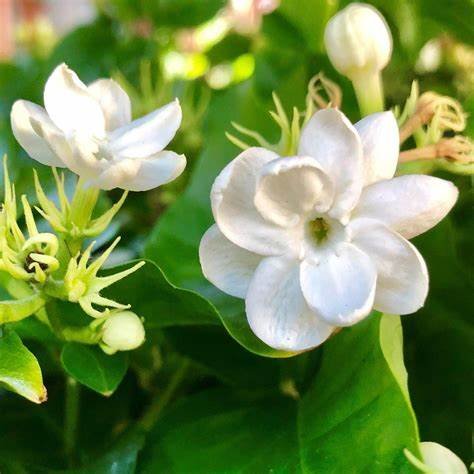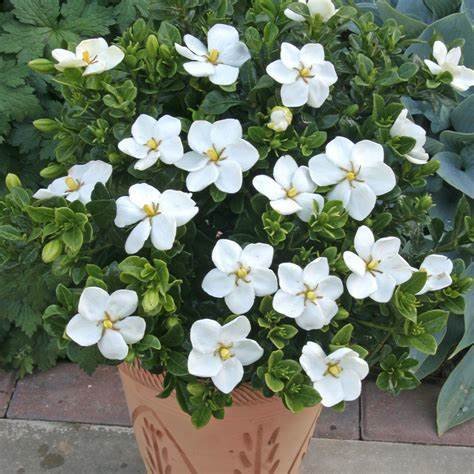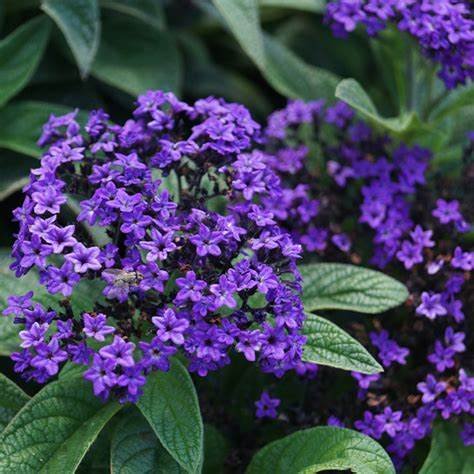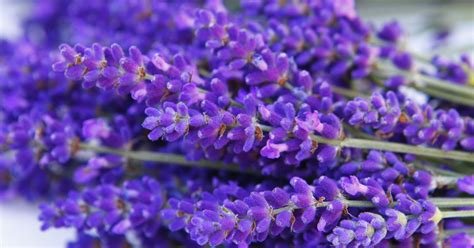Indoor Fragrant plants are known for their aesthetic appearance and health benefits but they serve our kitchen more than elegant and astonishing sight. They can also use to add flavor to numerous dishes. Flowering plants and herbs with their soothing fragrance can enliven our mood and make your kitchen smell pleasant and welcoming. Here 8 best fragrant indoor plants that can liven up your kitchen space. Let the fresh and soothing fragrance of indoor plants permeate your indoor space with the help of adorable potted plants.
“God grows fragrant flowers of hope in the ashes of loss.”
Jasmine

Jasmine is one of the most fragrant and climbing indoor vines with white flowers. The rich floral and heady scent can eliminate the bad odor of spoiled fruits and make you thrilled. It is very confusing to choose a fragrant vine from the 200 numerous species of jasmine but all are rich in fragrance. Jasmine is a sign of purity, modesty trust, and love.
Varieties of Jasmine
There are three main varieties of jasmine vine. Let’s explore them and select one of them for your kitchen space.
- Common jasmine or poet’s jasmine: twining climber with a cluster of glossy green leaves and small white flowers
- Winter Jasmine: old-timey shrub with yellow flowers and center of attraction for Hummingbirds.
- Star Jasmine or Confederate Jasmine: phlox-like flower on twining stems. It is more highly scented than other varieties.
How to grow and Care for Jasmine as a houseplant?
- Place jasmine in a sunny spot near a south-facing window of your kitchen.
- Jasmine enjoys sitting in moist and well-drained soil and breathing in well-circulated air.
- During the summer, let the topsoil completely dry between watering, less the quantity of water in fall, and water your plant rarely in winter or spring
- Fertilize your jasmine twice a year with fertilizer that has a lot of potassium and phosphorous quantity while feeding your hungry jasmine with a liquid fertilizer every few weeks during the active growing season ( spring or summer)
- Jasmine is utterly pest-free and disease free.
Scented Geranium | Indoor Fragrant Plants

If you are looking forward to a fragrant plant with a soothing and earthy scent, let me introduce you to a scented Geranium. There are numerous varieties of scented Geranium that has a fragrance like a coconut, limes, and even roses, and the flowers come in different hue (and color). It looks elegant and adds the vibrant color of hope to your life and only requires a sunny spot in return.
Geranium Caring Tips
- Place the lovely geranium on a sunlit windowsill because it loves bright indirect sunlight.
- Geranium is a drought-tolerant plant and hates overwatering. Water your thirsty plant when the topsoil becomes completely dry between watering again.
- Geranium wants to sit in moist, slightly acidic soil but not too damp.
- Avoid fertilization otherwise, your green friend feel dizzy.
- Pluck off any dead and affected leaves from the plant to encourage new growth.
Gardenia | Indoor Fragrant Plants

This evergreen graceful bush has gorgeous snow white or pale oval-shaped blossoms and a relaxing fragrance like white jasmine that can make your kitchen peaceful and you elated. It is a small and superb shrub native to china, japan, and Taiwan. It is also known as Cape jasmine. Gardenia is a symbol of modesty, geniality, courtesy, devotion, simplicity, and loyalty.
Uses of Gardenia Flower
- The sweet, intoxicating scent and striking look of Gardenia make this flowering plant a precious gift to a wedding ceremony or Christmas day.
- It is mostly used in perfumes, lotions, and candles.
- The American singer Billie Holiday embellish her hair with Gardenia flowers.
- You can adorn your home and balcony with a festoon (chain of flowers) of Gardenia Flower.
- Gardenia flower is used in gardenia essential oil, capsules, tea, and powder.
- You can get rid of brain fog, headaches, depression, bloody urine, and liver diseases.
How to Grow and Care for Gardenia Flower?
- Gardenia plants appreciate direct sunlight but don’t overheat otherwise burning heat scorch the beauty of gardenia flowers.
- It requires about one inch of water weekly and avoids watering this elegant flower with hard water instead of rainwater.
- It loves well-drained and slightly acidic soil to thrive. Always keep away from pets because it is toxic for your fur babies.
Hoya | Indoor Fragrant Plants

Everyone can fall in love with the beauty of Hoya due to its cute star-shaped flowers with floral balm and pheromone scent. You can call Hoya the name of the wax flower or porcelain flower. The petals of the Hoya flower have a double layer: on the outside, there are five medium petals and inside there are rows of five small petals.
Varieties and types of Hoya
- Hoya Carnosa: is one of the most common wax flower species with dark green leaves and white or pink petals with a deep red center.
- Hoya Bella: Wax flower with greyish-green leaves and white star-shaped flower with a pinkish-red center.
- Hoya Multiflora: they have one ring of white and one ring of yellow petals with pointed edges like arrowheads and wavy green leaves.
- Hoya Imperialis: Slightly curved pink-violet flower with the center of white petals.
- Hoya kerrii : Heart-shaped white flower
Heliotrope | Indoor Fragrant Plants

Heliotrope word is derived from the Greek word Helios means sun and Tropos mean to turn that’s why a Cluster of Heliotrope grow on one side and adore the sun. Some Horticulture claims that the scent of the flower is vanilla while other gardeners insist they smell like cherry pie. Its delicate fragrance can fill your kitchen with a pleasant scent and make you delighted.
How to Grow and Care Heliotrope?
- Heliotropes need six hours a day of direct sunlight and prefer partial shade of sunlight in the afternoon.
- Heliotrope enjoys moist and well-drained soil but is not waterlogged.
- Heliotrope grows well in warm weather and humid weather.
- Keep away from the approach of pets because it is perilous for the health of pets.
Passionflower | Indoor Fragrant Plants

Passionflower is a climbing vine and attracts everyone with its relieving fruity-floral fragrance and white, blue, or purple flowers. It is native to the southeastern United States and South America. It is also known as an apricot vine, maypop, and maracuja.
Healing Benefits of Passionflower
- If you are suffering from insomnia disease, you can use passionflower for improving sleep Quality.
- You can use passionflower to relieve stress and increase memory. You can get rid of nervous disorders, menopause, and stomach problems including ulcers.
- Just one cup of passionflower can help to reduce high blood pressure.
- It has been traditionally used to make passionflower tea, Tincture, and passionflower seed oil.
Lavender | Indoor Fragrant Plants

Lavender is a herb that originally grow in Northern Africa. Close your eyes, feel the sweet fragrance of lavender, and chill your life. You can use Lavender in numerous ways in your kitchen. It can help you to get rid of beetles, moths, mice, and insects. You can keep lavender buds in your kitchen cabinets and drawers to drive away insects from your kitchen.
Uses of Lavender
- You can make a syrup with lavender for the summer season. You can also use lavender buds for garnishing on desserts and baking bread.
- It is not just a pest repellent, Vibrant colors of lavender can adore your kitchen appearance and the fragrance of fresh lavender buds can make your day energetic.
- It is mostly used to add a floral taste to lamb and fish dishes.
- Lavender will show good results in enough light, moist soil, and good You can put lavender buds in your expensive clothes and fruit basket to repeal bugs.
- Lavender is good for hair growth. The south window of your kitchen is the best place for Lavender for receiving enough light.
Lily of the Valley

A kitchen is a place where you spend the most time with your family and nourish your family so, why not enhance its beauty with silver bell-shaped flowers? Tiny bell-shaped flowers hang on the thin stem, it seems it says welcome us by bowing their head.
How to Grow and Care Lily of the Valley?
- Lily of the valley love to full morning sun but hate the tropical sun of the afternoon.
- Lily of the Valley love well-drained and slightly acidic soil to thrive. Always keep away from pets because it is toxic for your fur babies.
- Temperatures between 60 and 70 degrees F are ideal for thriving the lily of the Valley.
Orchid | Indoor Fragrant Plants

Orchids are colorful flowering plants and are one of the most popular fragrant indoor plants. This tropical plant is native to Asia, and Central and South America. It has three petals and three sepals that joined together. If you want to add a pleasant scent to your kitchen space, place orchids in your own kitchen garden. They emit oxygen at night which helps you to take powerful and energetic sleep.
How to Grow and Care for Orchids?
- Orchids appreciate a lot of air around their roots instead of congested space so, keep it in terra cotta pots. A good ventilation system is a must for keeping contented your orchids.
- Some varieties of orchids can be picky about blooming so, be patient with getting flowers.
- Orchids prefer bright and strong indirect sunlight. If you notice the color of the leaves is dark green, it indicates your green friend can’t get enough light while yellowish-green or red leaves represent that plant getting an abundance of light.


